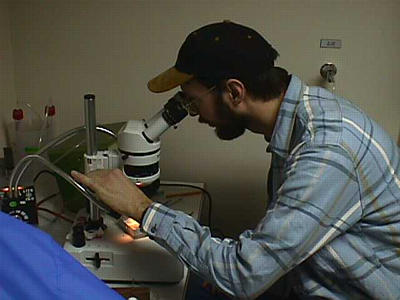
|
|
9 November, 1998
I was right... I dreamt soil, sediment, and sieving. I tossed and
turned all night (or at least it felt like it) and woke up at 7:00 am to
begin the day. Lots of soil samples to weigh today!
I ate breakfast and attempted to catch up on a few more e-mails. At
around 9:00 am, I began pulling my samples from the oven to allow them
to cool a little. I gathered the glass scintillation vials that I would
be putting my samples in, a Sharpie marker for labeling, and a balance.
I began weighing each sample, recording the weight, and placing each
into a 20-ml scintillation vial. Some samples were too big to put in
one vial, so I had to divide up the sample further into separate vials
(in case you're not keeping track, this creates more bottles...more
work!). This task took the rest of the day until 9:00 pm, with only a
break for lunch and dinner...I have to eat! It's sounds like I'm
complaining...I'm not...I just think it's important for people to see
how much work goes into getting a little bit of data. The guys on my
team keep saying, "Wow, you've at least gathered enough data for one
point on a graph!" That's about how it works. I've included a picture
of Mark Sappington, one of my team members, whom I have neglected to
introduce. He has been working with Jim on ice-active substances, and
in the picture, he is looking through a
microscope and, with the help of a nanoliter osmometer unit, he is
looking at freezing times of various substances. He let me look into
the microscope, and as he turned down the temperature, the small drops
of fluid instantly froze in succession. By working with this unit, he
can determine when substances freeze, but more importantly, how ice
crystals form. If a substance is allowed to freeze more slowly, it
forms different crystal patterns. In the afternoon, Mark was able to
get a perfect hexagon-shaped crystal, similar to the crystals formed by
that "antifreeze" substance I was talking about a couple of journals
ago. This allows them to make connections of similarities and
differences among substances.
I'm trying to set up a time to talk with my classes via speaker phone,
but it makes it a little hard to set things up when I'm a day ahead of
the the States and it's the weekend. Oh well, we'll keep trying. We
were going to set up a video teleconferencing event sometime, but
McMurdo has been having difficulty with their CU-SeeMe system down here,
so we'll try the phone call instead.
No time for exploration of McMurdo today...

Mark Sappington at the microscope and using the nanometer osmometer unit to see how substances freeze and form ice crystals.

Me weighing the many sediment samples I sieved yesterday. This process took me all day!

Look at the number of samples I weighed and logged today...you've got to be impressed!
Contact the TEA in the field at
.
If you cannot connect through your browser, copy the
TEA's e-mail address in the "To:" line of
your favorite e-mail package.
|
